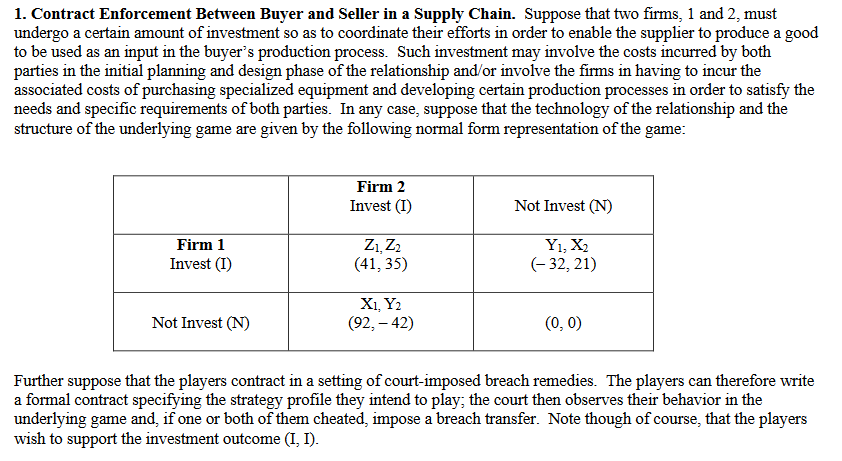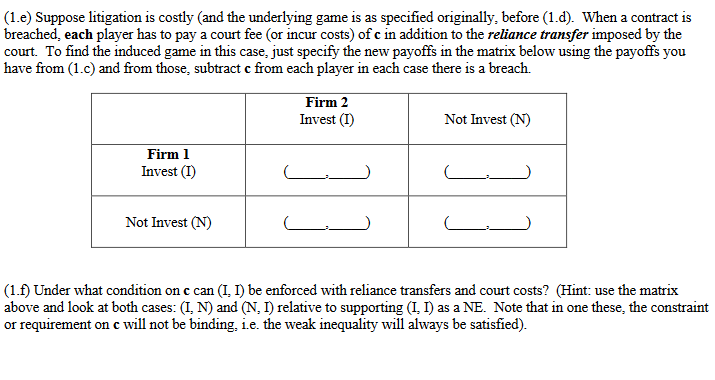(1.e) Suppose litigation is costly (and the underlying game is as specified originally, before (1.d). When a contract is breached, each player has to pay a court fee (or incur costs) of c in addition to the reliance transfer imposed by the court. To find the induced game in this case, just specify the new payoffs in the matrix below using the payoffs you have from (1.c) and from those, subtract c from each player in each case there is a breach. Firm 1 Invest (I) Not Invest (N) Firm 2 Invest (I) C C Not Invest (N) (1.f) Under what condition on c can (I, I) be enforced with reliance transfers and court costs? (Hint: use the matrix above and look at both cases: (I, N) and (N. I) relative to supporting (I. I) as a NE. Note that in one these, the constrai or requirement on c will not be binding, i.e. the weak inequality will always be satisfied).
(1.e) Suppose litigation is costly (and the underlying game is as specified originally, before (1.d). When a contract is breached, each player has to pay a court fee (or incur costs) of c in addition to the reliance transfer imposed by the court. To find the induced game in this case, just specify the new payoffs in the matrix below using the payoffs you have from (1.c) and from those, subtract c from each player in each case there is a breach. Firm 1 Invest (I) Not Invest (N) Firm 2 Invest (I) C C Not Invest (N) (1.f) Under what condition on c can (I, I) be enforced with reliance transfers and court costs? (Hint: use the matrix above and look at both cases: (I, N) and (N. I) relative to supporting (I. I) as a NE. Note that in one these, the constrai or requirement on c will not be binding, i.e. the weak inequality will always be satisfied).
Chapter13: General Equilibrium And Welfare
Section: Chapter Questions
Problem 13.12P
Related questions
Question

Transcribed Image Text:1. Contract Enforcement Between Buyer and Seller in a Supply Chain. Suppose that two firms, 1 and 2, must
undergo a certain amount of investment so as to coordinate their efforts in order to enable the supplier to produce a good
to be used as an input in the buyer's production process. Such investment may involve the costs incurred by both
parties in the initial planning and design phase of the relationship and/or involve the firms in having to incur the
associated costs of purchasing specialized equipment and developing certain production processes in order to satisfy the
needs and specific requirements of both parties. In any case, suppose that the technology of the relationship and the
structure of the underlying game are given by the following normal form representation of the game:
Firm 1
Invest (I)
Not Invest (N)
Firm 2
Invest (I)
Z₁, Z₂
(41, 35)
X1, Y2
(92,-42)
Not Invest (N)
Y1, X2
(-32, 21)
(0, 0)
Further suppose that the players contract in a setting of court-imposed breach remedies. The players can therefore write
a formal contract specifying the strategy profile they intend to play; the court then observes their behavior in the
underlying game and, if one or both of them cheated, impose a breach transfer. Note though of course, that the players
wish to support the investment outcome (I, I).

Transcribed Image Text:(1.e) Suppose litigation is costly (and the underlying game is as specified originally, before (1.d). When a contract is
breached, each player has to pay a court fee (or incur costs) of c in addition to the reliance transfer imposed by the
court. To find the induced game in this case, just specify the new payoffs in the matrix below using the payoffs you
have from (1.c) and from those, subtract c from each player in each case there is a breach.
Firm 1
Invest (I)
Not Invest (N)
Firm 2
Invest (I)
Not Invest (N)
(1.f) Under what condition on c can (I. I) be enforced with reliance transfers and court costs? (Hint: use the matrix
above and look at both cases: (I, N) and (N, I) relative to supporting (I, I) as a NE. Note that in one these, the constraint
or requirement on c will not be binding, i.e. the weak inequality will always be satisfied).
Expert Solution
This question has been solved!
Explore an expertly crafted, step-by-step solution for a thorough understanding of key concepts.
This is a popular solution!
Trending now
This is a popular solution!
Step by step
Solved in 3 steps

Knowledge Booster
Learn more about
Need a deep-dive on the concept behind this application? Look no further. Learn more about this topic, economics and related others by exploring similar questions and additional content below.Recommended textbooks for you

